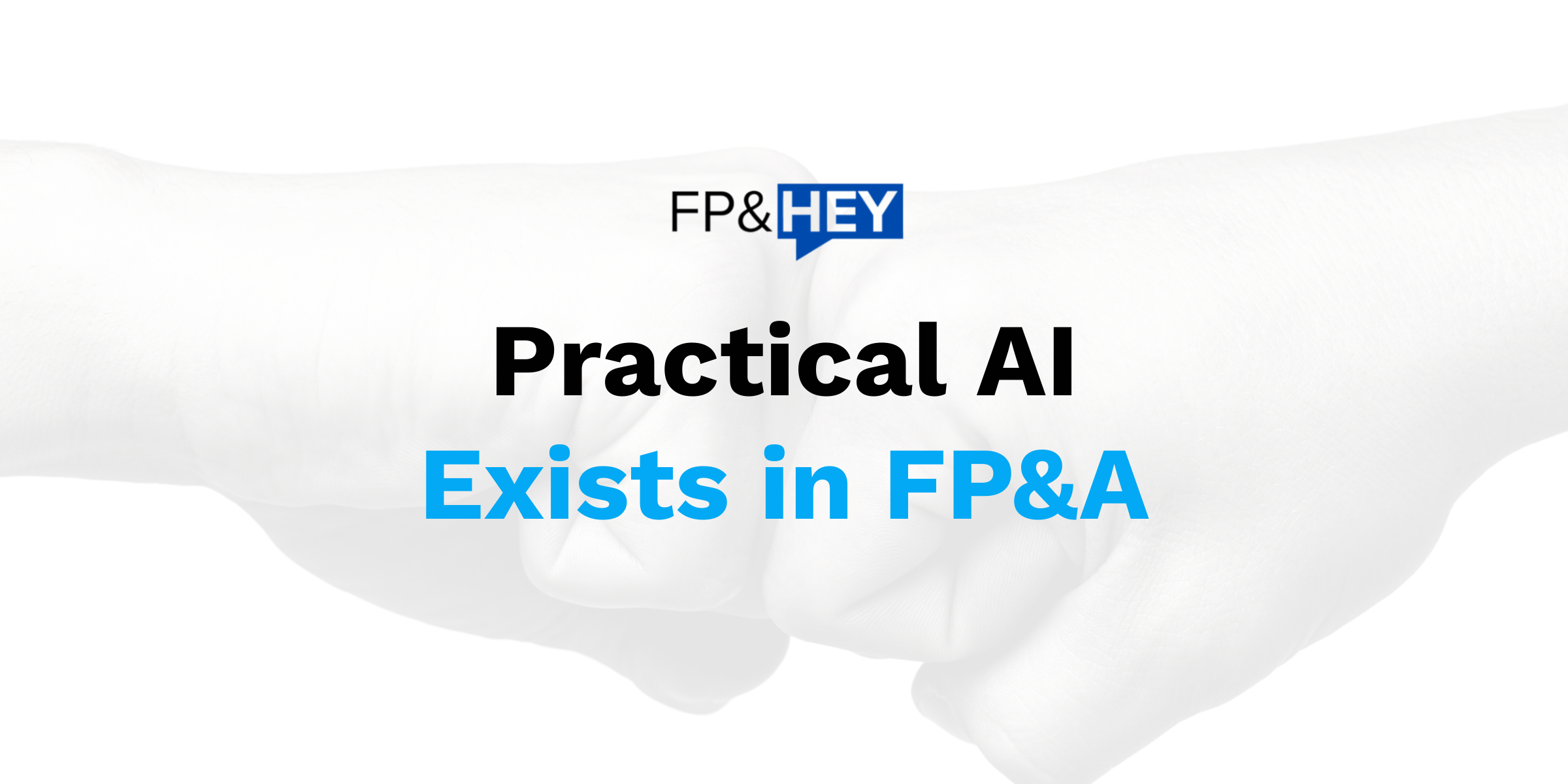What will it take for you to enter and move up the FP&A ladder?
Stumped? You’re not alone.
FP&A isn’t taught in school, so starting out can be a challenge.
And once you do start, the job titles in FP&A can drive confusion.

Let’s clear all that up.
Today’s topic is how to climb the FP&A ranks by navigating the 6 job levels.
We’ll cover the following:
- Why FP&A jobs are in demand
- How to get started in FP&A
- Tips to navigate the 6 FP&A job levels
Let’s dive in.
Discover High-Demand FP&A Careers
The world of business is in a state of uncertainty (as of 2023).
Generating positive cash flow is top of mind.
Interest rates are rising and growth is very hard to come by.
How can businesses navigate these challenging times?
By relying more on data to make decisions that drive positive cash flow.
Guess who does that extremely well?
FP&A.

FP&A Teams do a lot:
- Extract boatloads of data (clean or messy)
- Report financial and non-financial KPIs
- Provide actionable insights
- Connect business activities to the financial scoreboard
- Advise business partners to ensure goals are met
All of that takes some serious skill.

So how do you get started?
🔥Here’s more info on why FP&A is a good career choice.
Hit Your FP&A Career Launch Button
The hardest part about careers (and most things in life) is STARTING.
So where do FP&A professionals come from before they start?
Examples of FP&A newbies include:
- Accountants
- Big data gurus
- College grads
But you didn’t major in FP&A.
So what knowledge and skills are required to start?

Here are the FP&A basics to grasp BEFORE you begin:
- Understand Accounting (3 statements, journal entries, key concepts)
- Know how to use Excel (data tables, pivot tables, lookups)
- Be curious about how things work (systems, business models, products)
🔥Are you in Accounting? Here’s why FP&A could be a career option.
🔥Here’s your Excel lesson on data tables, pivot tables, and lookups.
🔥Ace your next FP&A interview by discussing these metrics.
Once you have the basics covered, it’s all about taking that 1st step into FP&A.
We break down all the FP&A steps into 6 job levels.
Understanding FP&A Job Levels
It’s worth repeating—job titles can be misleading.

Your job title could be Analyst, but you are operating at a CFO level doing all reporting, cash flow management, and strategy.
Or your title could be CFO of a business unit within a larger F100 company that focuses on financial reporting with no direct reports.
There is no right or wrong when it comes to FP&A job titles.
To understand FP&A job levels, we’ve given each a name for framework purposes only.
With that said, let’s start at Level 1.
Level 1: Analyst
Analysts prepare financial reports and basic analyses for finance and non-finance team members to consume.
Your day-to-day responsibilities as an Analyst may include:
- Financial reporting
- Forecasting and Budgeting support
- Adhoc data analysis and requests
🔥Here’s how to analyze and present variances—a key Analyst skill.
So what makes a great Analyst?
Speed.⚡
All of the tasks above require working with data.
Your work surface to manage data will mainly be Excel.
FP&A Analysts do really well when they realize time is their enemy.
Because your stakeholders will want info immediately.

And guess what helps you set Excel speed records?
Using Excel shortcuts.
🔥Learn these basic Excel shortcuts on day one.
If you want to be fast, learn ONE new shortcut every single week (10 min or less).
Over the course of a year, learning Excel shortcuts will make you the fastest data-generating person in your company.

And that data needs some insights to go with it.
Where do you go from here?
Start helping business partners make decisions using that data.
Level 2: Senior Analyst
Get ready to provide actionable insights to business partners.

Business partnering is when you engage with non-financial members in your company to make data-driven decisions.
Your day-to-day responsibilities as a Senior Analyst may include:
- Managing headcount reporting for HR
- Analyzing CLTV for Marketing
- Assessing customer churn for Customer Support
- Supporting a deal desk for the Sales Team
How do you know you are a great Senior Analyst?
Business partners will be knocking at your door fighting eagerly to get your support and advice. 💡

This is both a blessing and a curse because some people may be challenging to work with.
Be ready to receive positive and negative feedback.

Take positive feedback as a win, and any negative feedback as a growth opportunity.
🔥Here’s our guide to processing negative feedback.
Now you’re crushing data and helping your business partners make decisions.
And continuously getting better at your job because you take feedback like a champ.
Time to help others do exactly what you just accomplished.
Next up?
Diving headfirst into people management.
Level 3: Manager
Time to care about others more than yourself.
Say hello to team management.

Your day-to-day responsibilities as a Manager may include:
- Managing a team of direct reports
- Setting clear goals for your team and team members
- Holding weekly team meetings
- Having weekly one-to-ones with team members
- Providing growth opportunities for your team
- Aligning team expectations with your boss
What does it take to be a great Manager?

You must be organized like a coach. 📋
Winning will take the form of team goal achievement and individual development.
🔥Here’s how role rotation can spark individual development.
You know data, you know business partners, and now you are a team leader.
Imagine your team’s success multiplied by even more teams.
Next up—managing more than one team.
Level 4: Director
The people you manage are about to multiply like jackrabbits.

You are now responsible for multiple FP&A teams.
These teams could include financial reporting, business partnering, and strategy.
Your day-to-day responsibilities as a Director may include:
- Identifying areas that require the most improvement
- Proactively planning the next month, quarter, and year by the day
- Promoting collaboration and learning across your teams
- Understanding your teams’ capacity and capabilities
And you’ll start to own processes that rely on all of these teams to be successful.
An example of one of these processes is Profit Forecasting.
🔥Here’s everything you need to know about Profit Forecasting.
So how do you become a superstar Director?
Get all of your teams moving in the same direction to accomplish common goals, just like how a Director creates a movie. 🎬

When your FP&A teams succeed, leadership will start to notice you.
Now you have data, business partners, people management, and team management checked.

Next on deck—leading multiple functions.
Level 5: Vice President (VP)
You are now leaving the world of FP&A as you know it.

Owning multiple functions is your next challenge.
Functions are specialized departments.
Examples include:
- FP&A
- Rev Ops
- Business Intelligence
Your day-to-day responsibilities as a VP may include:
- Connecting company goals to daily business execution
- Ensuring consistent data flows across all departments
- Owning data governance
- Being the right-hand person to your CFO
🔥Here’s how you can help your company hit quarterly revenue goals.
So what do the best VPs do?
Teach. 👩🏫
You’re a great VP when you constantly make your teams better doing things like:
- Sharing your own experiences (good and bad)
- Leveraging the experts in your own team to share their knowledge
- Being open to trying new things to save time (systems, processes)
Watch your teams thrive from one year to the next.
All because you helped them get just a little better EVERY day.
So at this point in your FP&A career, you have:
✅ The data thing down
✅ Business partners knocking
✅ Super organized and motivated teams
✅ Processes firing on all cylinders 24/7
✅ Teams performing at a high level and constantly improving
Only one level left in your FP&A career ladder.
Time to take the lead role.
Level 6: Chief Financial Officer (CFO)
Congrats!
You now own everything.

That includes all numbers and the people that produce them.
As Chief Financial Officer, your day-to-day responsibilities may include:
- Setting the company strategy
- Establishing company KPIs and hitting them
- Working directly with the CEO to make decisions
- Managing company risk
- Conveying the company’s financial narrative to investors
🔥Learn how to set goals and KPIs to drive company performance.
So what do amazing CFOs do?
The textbook answer is to manage a business that hits and/or exceeds all financial targets.
Our answer?

Inspire by giving credit where credit is due.
To whom?
To your supporting team.
They do this by not using words and emails.
Instead, they revisit and touch EVERYTHING your organization does.
We call this servant leadership.
You’ll know when you inspire your fellow team members and colleagues.
They’ll say THANK YOU a bunch and keep asking to work with you.
This is what drives long-term business success.
Conclusion: Embark on your FP&A Journey One Step at a Time
You now can see a path to entering and excelling in FP&A.
Remember, the hardest part of a career is STARTING.
Be confident, be yourself, and be helpful to those around you.
And don’t forget to brush up on your Accounting, Excel, and people skills.
You got this FP&A career thing. 👊
Anything we missed in our post? Is there another level you would add?
Let us know by replying to this with your experiences and thoughts.
Now go have fun making an impact on your business and your career!
Cheers,
Drew & Yarty
Follow us on LinkedIn





